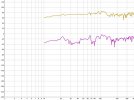UltraNearFieldJock
Active Member
- Thread Starter
- #21
Yes, this problem (stage) was for me the main reason to make experiments with ultra-near-field. But not caused by my living-room setup. I find my standard living-room-setup good enough - naturally in the frame of costs, efforts and possibilities – it makes a lot of fun. But I never haven’t got unfortunately enough free time to sit workless and listen to the music :-(. And when I have, it's too late in the night to listen loud enough – I live in a flat. Due to this, I was very long time an enthusiastic headphone listener. But one time (for more then 2 years) I said enough – I will have a more real phantom-stage, and not a one in the middle of my had! And I started to experiment. And now I’m writing this post, is 01:25 am and I’m listening to the music in the quality, loudness and phantom-stage, it really satisfied me – without any thing in or over ears. And tomorrow ours main aspect: the phantom-stage-issue.... but retaining the phantom scene projected in front of you. But all this has some limit, if positioned extremely close, then the phantom scene goes up to your head and if even closer it gets then inside your head, losing the front projection effect, which in my opinion it's not desirable.
Last edited:


